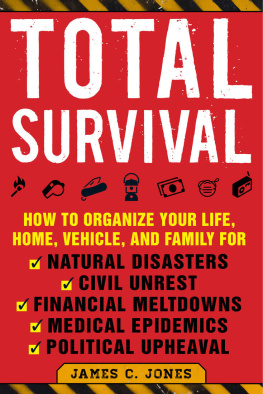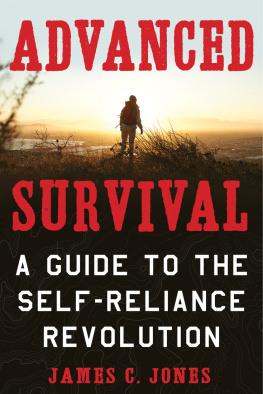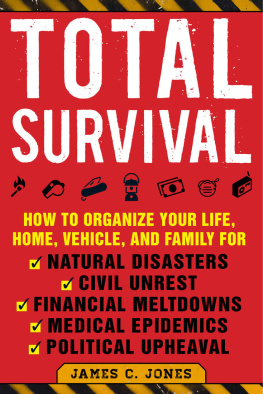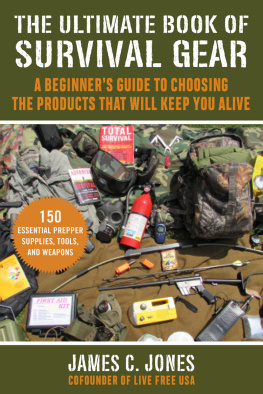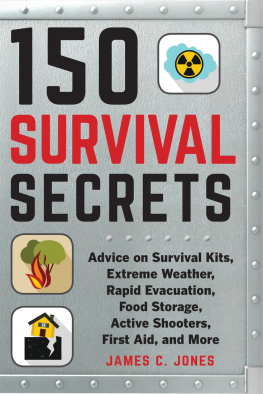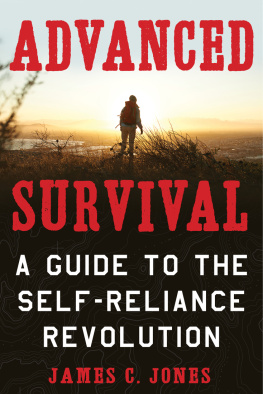James C. Jones - Total Survival
Here you can read online James C. Jones - Total Survival full text of the book (entire story) in english for free. Download pdf and epub, get meaning, cover and reviews about this ebook. year: 2018, publisher: Skyhorse, genre: Home and family. Description of the work, (preface) as well as reviews are available. Best literature library LitArk.com created for fans of good reading and offers a wide selection of genres:
Romance novel
Science fiction
Adventure
Detective
Science
History
Home and family
Prose
Art
Politics
Computer
Non-fiction
Religion
Business
Children
Humor
Choose a favorite category and find really read worthwhile books. Enjoy immersion in the world of imagination, feel the emotions of the characters or learn something new for yourself, make an fascinating discovery.
- Book:Total Survival
- Author:
- Publisher:Skyhorse
- Genre:
- Year:2018
- Rating:4 / 5
- Favourites:Add to favourites
- Your mark:
- 80
- 1
- 2
- 3
- 4
- 5
Total Survival: summary, description and annotation
We offer to read an annotation, description, summary or preface (depends on what the author of the book "Total Survival" wrote himself). If you haven't found the necessary information about the book — write in the comments, we will try to find it.
Total Survival — read online for free the complete book (whole text) full work
Below is the text of the book, divided by pages. System saving the place of the last page read, allows you to conveniently read the book "Total Survival" online for free, without having to search again every time where you left off. Put a bookmark, and you can go to the page where you finished reading at any time.
Font size:
Interval:
Bookmark:



Copyright 2019 by James C. Jones
All rights reserved. No part of this book may be reproduced in any manner without the express written consent of the publisher, except in the case of brief excerpts in critical reviews or articles. All inquiries should be addressed to Skyhorse Publishing, 307 West 36th Street, 11th Floor, New York, NY 10018.
Skyhorse Publishing books may be purchased in bulk at special discounts for sales promotion, corporate gifts, fund-raising, or educational purposes. Special editions can also be created to specifications. For details, contact the Special Sales Department, Skyhorse Publishing, 307 West 36th Street, 11th Floor, New York, NY 10018 or .
Skyhorse and Skyhorse Publishing are registered trademarks of Skyhorse Publishing, Inc., a Delaware corporation.
Visit our website at www.skyhorsepublishing.com.
10 9 8 7 6 5 4 3 2 1
Library of Congress Cataloging-in-Publication Data is available on file.
Cover design by Tom Lau
Print ISBN: 978-1-5107-3900-0
Ebook ISBN: 978-1-5107-3902-4
Printed in the United States of America.
A fter fifty years of writing, teaching, and advocating for survival preparedness and self-reliance, I have covered about every survival-related subject there is. Most of my materials exist in short articles, class outlines, PowerPoint programs, and notes. I also have a vast library of references and photos from various survival-training activities. While my most original works are devoted to the psychological and philosophical aspects of survival, I do address the more practical nuts-and-bolts aspects as well.
The challenge when preparing this book was to organize all the material in a coherent way. There are hundreds of survival manuals in publication, and I did not want to simply create another one. No survival book can cover every conceivable aspect of surviving every conceivable situation, so I decided to focus on subjects that I felt were the most likely needs and that I could create useful and practical chapters to cover.
Ten is a rather arbitrary number, but it helps to organize the material into manageable bites of knowledge. As I developed each chapter, I stretched or bundled material to fit the ten-subject standard. In some cases the same item applied to more than one category. For example, water applies to the water chapter, but it also comes up in home survival and in various survival packs. In such cases, I either referred the reader to the appropriate chapter or added some additional information not previously provided. I tried to cover the ten most important items in each category where possible, but there is no point in listing an item unless I could provide some useful information within a reasonable number of pages. So, this guided my choices. When any of the ten items took me a bit out of my knowledge wheelhouse, I did extensive research and combined multiple sources to provide the most useful information within a reasonable space. Some items within a subject chapter inspired more text or illustrations than others, particularly if the subject was not addressed in other chapters.
Where necessary, I have added lists, tables, and other materials at the end of chapters to further enhance their value. Some subjects required significant illustrations while others are primarily text. I used a combination of photos from my personal library, illustrations from military manuals, and some of my own illustrations where needed. While most of the subject material is covered in other survival manuals, I have added my own perspectives based on my fifty years of experiences and study. As I addressed each topic, my self-imposed ten theme forced me to organize materials in new ways and look at alternatives not always considered. In many cases I realized that I had some valuable experiences, tips, illustrations, and techniques to contribute to the subject drawn from classes and programs conducted by Live Free USA. My goal here is to share a variety of practical survival skills, principles, and ideas in an easy-to-read format that will aid the reader in becoming stronger, safer, and more self-reliant.
N one of the survival precautions, methods, procedures, and techniques that are explained and advocated throughout this book will be of any value if your mental state and psychological condition render you unable to function effectively. Mental survival is the fundamental necessity for physical survival. The principles enumerated below are derived from analysis of true survival accounts. Studies of why some people survived fires, plane crashes, assaults, and other deadly situations while others in the same situations perished confirm that these principles made the difference. I have extracted the lessons from these sources and organized them into the following ten principles.
Although the data and concepts were derived from accounts of acute (rapidly developing) disasterssuch as tornadoes, floods earthquakes, and epidemicsI realized that they apply equally well to chronic (slow-developing and persistent) disasters, such as economic decline, shortages, unemployment, climate change, and personal family or health issues. Finally, I came to the realization that these principles were the key to success in everyday life. In truth, all of life is a low-intensity survival challenge, and a survival emergency is just a high-intensity life challenge. People who have survived the worst disasters have usually done so by following these principles, and those who have had successful lives have done the same.
Before we get to the ten principles, we need to discuss the importance of the mental aspects of survival.
It is important to understand the stages that the mind goes through when it encounters an unpleasant or dangerous situation. Again, these apply equally to a sudden-hazard event or a developing bad situation. Once we recognize (at least subconsciously) that something is wrong or going wrong, our mind begins to cope. The ten principles are important in determining how quickly and effectively we move from denial to action. In acute emergencies, we go through the four stages within seconds or minutes or we dont survive. In the cases of slow-developing, chronic disasters, the process is slower and we may not even recognize our mental adaptation, but lingering too long before getting to effective action can still result in serious consequences. Time always runs out!
Denial is often verbalized in such phrases as, This cant be happening! Oh no! or Youve got to be kidding! People commonly rationalize scary events to avoid dealing with them: A fire alarm must be a false alarm. Shots must be firecrackers. Chest pain must be indigestion. The weather cant get any worse. It wont be that bad; surely things will turn around. While panicking at every slight sign of trouble is certainly unhealthy, it is far more dangerous to ignore clear signs of potential hazard without further consideration. Remember, we are all the descendants of people who heard the rustling in the bushes and ran like hell. The ones who shrugged and said, Its probably nothing, didnt have descendants.
Font size:
Interval:
Bookmark:
Similar books «Total Survival»
Look at similar books to Total Survival. We have selected literature similar in name and meaning in the hope of providing readers with more options to find new, interesting, not yet read works.
Discussion, reviews of the book Total Survival and just readers' own opinions. Leave your comments, write what you think about the work, its meaning or the main characters. Specify what exactly you liked and what you didn't like, and why you think so.

